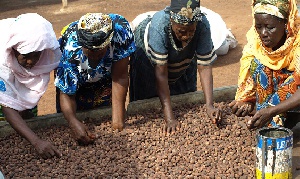Shea-nut farmers and buyers in the Northern Region have expressed worry about the reckless felling of shea trees in the area.
Mr. Zakaria Iddi, National Coordinator Shea nut Network Ghana who expressed this, said if the practice is not stopped it could worsen the poverty situation in the north since shea is only source of income to many households.
“Declining population of shea trees associated with increasing desertification of the savannah agro-ecological zone raises concerns about sustainability of the shea industry,” he stated.
Mr. Iddiwho spoke to the B&FT appealed to Ministry of Food and Agricultural to initiate steps to address the indiscriminate cutting of shea trees in the country.
“It important for district assemblies and traditional rulers to team up and assist in stopping the practice of cutting down shea trees,” he said.
He hinted that association on its own is trying to come out with measures aimed at addressing some of challenges confronting the shea industry.
In this regard, he said that the association will form cooperatives among shea pickers and producers, which will give them more bargaining power.
He noted that the association is also planning to structure the ownership of shea trees in the various communities to avoid any future havoc, since there is no proper document on the land acquired.
He said the information on ownership and management of the shea resource between communities, and even within communities and traditional authority, is necessary and can help to reduce the cutting down of shea trees.
The National Coordinator added that the shea-nut tree holds great potential for contributing significantly to reducing poverty in the north, hence the need to institute measures that sustain and improve its viability.
Shea-nuts are the seeds of the shea fruit that grows on the shea tree. The shea generally grows wild and is an indigenous tree species to many countries in West Africa. They begin to bear fruit after 20 years and do not reach maturity for 45 years. They may continue to produce nuts for up to 200 years after reaching maturity. The Shea fruit fall to the ground during the harvesting period (typically June through August).
They are then buried in a pit, which causes the pulp to ferment and disintegrate and produces enough heat to prevent germination. The Shea nuts are dried for a few days and are later shelled and winnowed, usually by hand. The kernels are dried further to reduce moisture content from about 40 percent to about 7 percent.
The long period taken to reach maturity has discouraged plantation planting, although they are used as shade-trees for other crops in certain dry areas.
Seemingly, buyers specify their own quality standards for the purchases of shea nuts and shea butter.
It contains six percent free fatty Acids, seven percent moisture content and 45 percent oil content that are good for human consumptions. Shea nut products, the solid fat (butter or stearin) and the liquid oil (olien), are ideal for use locally as raw materials in cooking oil, margarine, cosmetics, soap, detergents, biscuits, candles, butter for the skin and hair among others
Its supply far outstrips demand, with over 60,000 m/t of dominant variety Vitellaria Paradoxa produced in West Africa. Several other countries, including Israel and Germany, have attempted to replicate this variety without success.
Shea butter is becoming increasingly popular as an ingredient in cosmetics and soaps, especially in Ghana, France and the US. Chocolate and confectionery products account for 95 percent of shea butter demand, with only 5 percent currently used for cosmetics and pharmaceuticals.
Individual companies specify their own quality standards for purchases of shea nuts, which is creating a problem for the industry -- but if care is taken could contribute a greater part to the economy.
The oil content is the most crucial element of the shea nuts, as that component is an important ingredient in the composition of butter that goes into Cocoa Butter Equipment (CBEs) and other by-products.
Business News of Friday, 13 December 2013
Source: B&FT

















